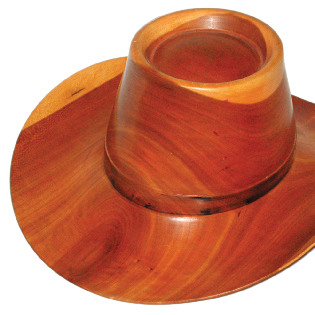
MADE ON EARTH
THE WORLD OF BACKYARD TECHNOLOGY
Circuit Court of Appeals
While working as a computer sales consultant nearly 20 years ago, Canadian artist Peter McFarlane was profoundly struck by the rapid evolution of electronics and the subsequent volume of electronic waste. He was determined to give new life and meaning to these discarded parts. McFarlane re-contextualizes circuit boards into canvases masterfully overlaid with old wires and obsolete components to mimic images of nature and his surrounding environment, turning “landscrap” into landscape. He aptly states, “To me, waste is just lack of imagination.”



Peter McFarlane
Silica Speakers

Shawn Ayerst
With his impressive Ohm Sound installation, glass artist Shawn Ayerst has both audio and visual stimulation down pat. The Albertaborn artist first got into glass-blowing nearly a decade ago, but it was a multiday intensive yoga workshop a few years back that gave him the idea to combine tactile art with sound.
“We were in the middle of a chant on our fifth day, and I could specifically hear the voice of one of my teachers coming from a few rows diagonally behind me,” says Ayerst. “It made me think about where sound originates and how it provides energy.”
Ayerst created Ohm Sound in 2010 while a student at Alberta College of Art & Design, using molten silica to color, blow out, and shape six cone-shaped glass speakers, which he then cooled in an annealing oven for approximately 20 hours. He next added the electrical components — including amplifiers and receivers, attached each speaker to a wood-based metal stand, and displayed them in an empty room in two widely spaced rows of three.
To fully experience Ayerst’s multisensory piece, which is no longer on display, the viewers walked into the room’s center, where an ultrasonic sensor triggered three different chant recordings, each with left and right individual audio designed to play at various times. “It’s all about perception,” says Ayerst. “When the sound starts from behind, you feel yourself pulled, and then it comes from a few feet ahead of you and your awareness is brought somewhere else. [Familiar sounds] can lift you out of your thoughts into someplace bigger.”
Playing with Firewall

Yang Jiang Photography
Michael Allison and Aaron Sherwood are both musicians and performance artists who partnered to create Firewall, an interactive performance object that’s made of a piece of spandex stretched across a large frame. A Kinect senses the depth and position of how the spandex is manipulated by the user, and responds with projection and music. A Processing sketch handles the fiery visuals, while a Max/MSP patch manipulates a MIDI track that plays music in concert with the user’s movements.
For a final project in their physical computing class at NYU’s Interactive Telecommunications Program, Sherwood wanted to work on a piece that could be used at the Tribeca Performing Arts Center, where he has a residency. “I wanted to create some sort of interactive membrane or wall that the dancers could press into but be trapped behind,” he says. “I saw an early video experiment Mike posted online of people pressing into latex and projecting on it using a Kinect. I had already been thinking I’d like to work with Mike at some point, so I suggested we team up.”
Sherwood focused on the music while Allison worked on the visuals. Firewall “really came together when we combined both of these,” says Sherwood. “All of a sudden the piece seemed like it might be something really special.” They debuted Firewall to the public at ITP’s Winter Show last December. “Watching faces light up with wonder was something I’ll never forget,” Allison reflects. “I live by a philosophy of positivity and optimism, and sharing that kind of joy and wonder couldn’t have made me happier.”
Perhaps the Ending Has Not Yet Been Written

Mike Ando
Like many PC owners in the 90s, I loved the point-and-click adventure game Myst. The rich mythology behind the sparse but intriguing narrative kept me hooked, even as I glared at the screen for hours to solve the often-inscrutable puzzles. So imagine my excitement when I saw Mike Ando’s gorgeous recreation of a Myst linking book, which, in the game, teleported characters to other worlds.
“The Myst series means a lot to me,” Ando says. “I’ve created a couple other pieces of Myst fan art over the years, and I wanted to make something truly epic.”
Ando, of Coorparoo, Australia, recreated the window-like aesthetic of the books in the game using a 5-inch LED-backlit touchscreen connected to a fully working PC that’s smaller than most laptops and fits inside the book. Every Myst game is playable, along with some familiar videos from the series.
Matching the look and feel of the book was also a key factor. After seeing the original copy of Harper’s New Monthly Magazine that was used by the game's creators as a texture reference during a fan convention, Ando settled on a 135-year-old copy of the same book as the closest usable match. While it might sound like a waste to gut an old book, he notes that interior designers buy them in bulk for the aesthetics of the spines, not the content. His book “is basically a cross between a Reader’s Digest and a gossip magazine, and many of the articles are incomplete.”
While the specs are impressive, it’s Ando’s dedication to detail that makes the project so striking. “A couple people had created replica Myst books by inserting a picture frame inside an old book, and these look great, but I thought I could do a better job. What can I say? I have high standards.”
TIMBER TOPPER




Carl Stoner
I met Carl Stoner at Maker Faire New York, where he was a volunteer. Actually, I met his wooden hat first, as I was enamored with the idea of a wooden hat that actually looked comfortable to wear.
To create one of these stiff-brimmed beauties, Sharon Springs, N.Y.-based Stoner uses a freshly cut 18"-diameter log, and when he starts turning, he doesn’t stop until it’s finished — usually within a few hours. The wet wood is shaped to about 3/32", and on the lathe the water is spun out from the thin areas. He has to ensure that the wood is completely even, or it will crack. After sanding, he puts it in a press to give it its oblong shape, using large rubber bands to get the curve in the brim. Sanding is followed by a polyurethane finish, and just like that, another handsome hat is hewn.
